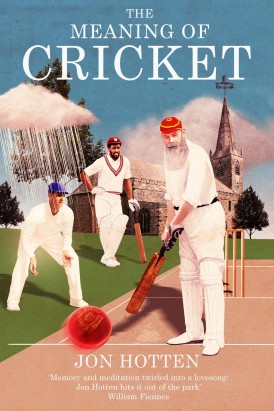The Meaning of Cricket
Martin Chandler |Published: 2016
Pages: 224
Author: Hotten, John
Publisher: Yellow Jersey Press
Rating: 4 stars

Back in 2016 this one slipped under my radar. That it should have done so troubles me, as it was published at around the same as I read The Test, Simon Jones’s autobiography, which Hotten had been responsible for writing. I suspect, for the reasons I outlined in my review, that The Test was always going to be a cut above the usual player autobiography, but there was never any doubt in my mind that the fact that it was two cuts above the rest was down to how well Hotten had done his job.
As I get older I do struggle with names occasionally, and the simple fact that I didn’t link The Test with The Meaning of Cricket may be down to that fact alone. I have to say however that I don’t find the title of the book particularly appealing, and I didn’t like the dust jacket to start with, although I warmed to that once I had actually bothered to read the book and realised where it was coming from. I can also say that, whilst leafing through the cricket section in our local Waterstones, I would not have been impressed by the lack of any photographs, an index or statistics – my bad again, as none are necessary.
I still think the title is a little misleading, although like the jacket the reader acquires a different perception of it once they have got into the book. I will therefore say at the outset that this is not a self-indulgent attempt to define what cricket is all about. In a sense it is rather more pedestrian than that in that there is no grand conclusion, or earth shattering summary of Hotten’s findings. The Meaning of Cricket is in fact nothing more than a collection of short essays, most of which started out as blog posts, which are then pulled together into eight broad chapters before a final chapter, appropriately entitled, Time Slows the Rapid Eye, revisits some of the earlier subjects.
The Meaning of Cricket is certainly not an autobiography, but Hotten draws on his playing experiences to illustrate some of the points he wants to make about the First Class and international game. He was clearly a good batsman himself in his youth, and there are plenty of stories of his own experiences. I particularly enjoyed the brief account of the occasion that he, along with a number of other youngster, faced Malcolm Marshall in the nets. In his youth Hotten also attended the famed Alf Gover Indoor School in Wandsworth. Many, many cricketers passed through the school over the years, and it is mentioned many times by famous players’ books and indeed Gover himself wrote an autobiography. Not however until I read The Meaning of Cricket did I have any semblance of understanding as to what attending the school might actually have been like.
If you like your cricket writing in bite sized pieces that is another reason to read Hotten’s book. He skilfully chooses aspects of the playing careers of the great and the good without ever leaving his reader feeling short changed. His contribution on the subject of Geoffrey Boycott is a good example, as he uses ‘that over’ from Michael Holding in 1986 and Boycott’s unique acceptance on that occasion that there was nothing he could have done to prevent his dismissal from the final delivery of a magnificent over.
Inevitably his relationship with Jones puts Hotten in an excellent position to understand the pressures that modern players have to contend with. The stories of men like Marcus Trescothick, Jonathan Trott and Steven Harmison are now well known, but Hotten explores the psyche of a number of Jones’s England contemporaries and provides some fascinating insights and observations. From another generation he takes a look at the ultimately tragic life of Peter Roebuck, and from another continent he left me finally understanding a little of the travails of Vinod Kambli. The effect of retirement from the game is also looked at – back to Boycott again, amongst others.
The content of The Meaning of Cricket is certainly not limited to the modern era. Centrestage on the jacket is the Grand Old Man himself, and he crops up in several places in the text. Hotten also goes even further back to the likes of ‘Silver Billy’ Beldham, David Harris and Alfred Mynn. Moving forward Arthur Collins (he of the 628* in a house match at Clifton College in 1899) has his story told, which is followed by recent assaults on that record from the sub-continent, and shortly afterwards the name Prithvi Shaw gets an airing.
Although it is now approaching three years since The Meaning of Cricket was published it is, certainly in paperback, still in print, and copies are readily available on the second hand market. It really is an excellent read and, unlike some of the books in respect of which I have made that comment, will appeal to anyone with any sort of interest in the game.






Leave a comment